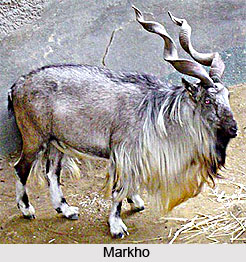 Markhor, an Indian wild goat (Capra falconeri), is distinguished by the flattened keel of its horns which in males twist in a corkscrew shape. There is much variation in the shape of its horns which has resulted in the description of a number of subspecies. Adult males stand less than a metre at the shoulder, and the northern races have horns measuring about one hundred and fifty centimetres in length. It has a blackish muzzle and ears, and a ruff of longer white hair down its chest and along its spine. Females are reddish-brown with short twisted horns and, like the males, white-stocking legs.
Markhor, an Indian wild goat (Capra falconeri), is distinguished by the flattened keel of its horns which in males twist in a corkscrew shape. There is much variation in the shape of its horns which has resulted in the description of a number of subspecies. Adult males stand less than a metre at the shoulder, and the northern races have horns measuring about one hundred and fifty centimetres in length. It has a blackish muzzle and ears, and a ruff of longer white hair down its chest and along its spine. Females are reddish-brown with short twisted horns and, like the males, white-stocking legs.
Markhor inhabits the most precipitous cliffs and crags in the higher arid mountain ranges of Blauchistan and the northern Himalayas. A small population survives precariously in the PirPanjal range of India. Markhor is much prized as a trophy by the local hill people and its number has declined throughout its range due to this hunting pressure. Small population also occurs in Afghanistan and Soviet central Asia.
Markhor grazes grass and browse on shrubs and is active mostly in the early morning and late afternoon. Young males and females keep together in small bunch, the older males remaining solitary and staying at higher altitudes except during the rut which is in the later parts of the month of November. At this time the males emit a pungent goaty odour and fight each other for possession of estrous females, rising high on their hind legs and crashing their horns sideways down on to their opponent.
This article is a stub. You can enrich by adding more information to it. Send your Write Up to content@indianetzone.com











